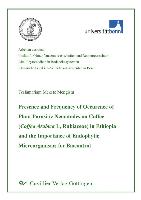Presence and Frequency of Occurence of Plant Parasitic Nematodes on Coffee (Coffea Arabica L, Rubiaceae) in Ethiopia and the Importance of Endophytic Microorganisms for Biocontrol
BücherAngebote / Angebote:
A survey was conducted to determine the occurrence and distribution of plant-parasiticnematodes and associated endophytic fungi and bacterial antagonists on coffee inEthiopia. Soil and root samples were collected from 15 coffee growing agroecologiesduring the wet season in August 2004 and dry season in April 2006. The dominantplant-parasitic nematode genera found were Helicotylenchus, Scutellonema, Rotylenchus, Xiphinema, Heterodera, Tylenchorhynchus and Quinisulcius.Helicotylenchus predominated throughout the area (65-74%), followed by Xiphinema(29-40%). Nematode densities were generally higher in the wet season than in the dryseason, however, relative abundance of nematode taxa was in the same order. For themajor plant-parasitic nematode genera, specimens were identified to the followingspecies: Helicotylenchus dihystera, H. multicinctus, H. californicus, H. gerti, Xiphinemainsigne, X. basilgoodeyi, Scutellonema paralabiatum, Rotylenchus unisexus, Tylenchorhynchus agri and Quinisulcius capitatus. Nematodes considered to be ofeconomic importance and involved in coffee decline were not detected in this survey.A total of 128 fungi growing endophytically were obtained from surface sterilized coffeeroots. The most frequently detected genera were Fusarium and Trichoderma.Nematicidal effects of culture filtrates of these isolates on M. incognita juveniles wereobserved after 24 h of incubation. Juvenile inactivity ranged from 28% to 81% in whichTrichoderma strain ET2 showed the highest level of inactivity up to 81%. Same isolateswere tested for their pathogenicity towards M. incognita eggs. Isolates EF1, EF3, EF5, EF6, EF8, EF10, EF11, EU2 and EU4 showed the highest ability to infect eggs withvalues up to 89%. The percentage of egg pathogenicity was highest for Fusarium spp.Results of replicated greenhouse experiments demonstrated that isolates of Fusariumand Trichoderma reduced the number root-knot nematode egg masses up to 50%. Ofall the tested isolates, the F. oxysporum isolate EF11 significantly reduced the numberof egg masses in all sets of experiments. Reduction in nematode penetration ranging upto 30% was also recorded in the present study for isolates EF11 and EF10.Endophytic bacteria were isolated and identified by Fatty Acid Methyl Ester-GasChromatography (FAME-GC). A total of 201 and 114 endophytic bacteria were isolatedand identified during the wet and dry seasons, respectively. The most abundant generafound were Pseudomonas, Bacillus, Agrobacterium, Stenotrophomonas andEnterobacter. Higher population size densities ranging from 5.2 x 103 to 2.07 x 106 cfu g-1 fresh root were observed during the wet season. Culture filtrates of the bacterialisolates showed nematicidal effects ranged between 38% and 98%. The active strainswere: Agrobacterium radiobacter, Bacillus pumillus, B. brevis, B. megaterium, B.mycoides, B. licheniformis, Chryseobacterium balustinum, Cedecea davisae, Cytophaga johnsonae, Lactobacillus paracasei, Micrococcus luteus, M. halobius, Pseudomonas syringae and Stenotrophomonas maltophilia. Bacillus pumillus and B.mycoides were the most effective strains in reducing the number of egg masses andgalls up to 39 and 33%, respectively.
Folgt in ca. 2-3 Arbeitstagen
